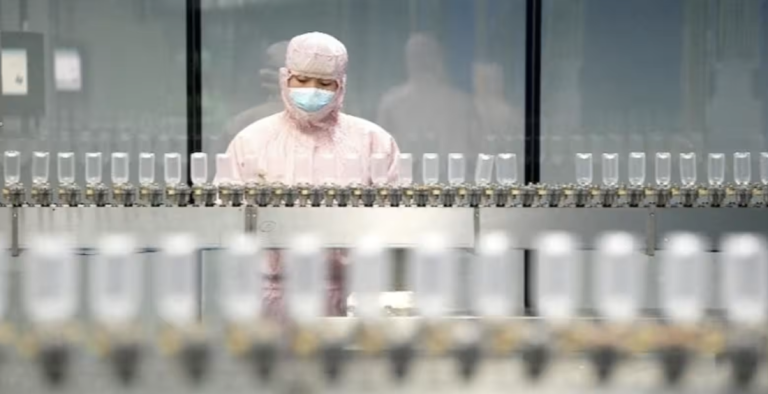
Boston, MA –– Long overshadowed by its dominance in artificial intelligence and manufacturing, China is now making waves in a sector critical to global health: pharmaceuticals. Bolstered by aggressive government investment, a thriving biotech ecosystem, and a surge in cross-border partnerships, Chinese drugmakers are rapidly transitioning from producers of generic medicines to pioneers of cutting-edge therapies, challenging Western pharmaceutical giants and reshaping the global industry.
Breakthrough Therapies Redefine Global Standards
Chinese pharmaceutical firms are achieving milestones once thought unattainable. In late 2024, an experimental cancer immunotherapy developed by Akeso Inc. outperformed Merck’s blockbuster Keytruda in a late-stage trial for non-small-cell lung cancer, nearly doubling progression-free survival rates. This marked the first time a Chinese-origin drug surpassed a leading Western therapy in a head-to-head trial.
Similarly, Jiangsu Hengrui Pharmaceuticals’ trio of GLP-1 receptor agonists, licensed to U.S.-based Kailera Therapeutics in a landmark $6 billion deal, positions China at the forefront of the obesity drug market—a sector projected to exceed $150 billion by 2030. These breakthroughs underscore China’s shift from “me-too” generics to novel mechanisms of action (MoA), including bispecific antibodies, RNA interference (RNAi) therapies, and antibody-drug conjugates (ADCs).
Cross-Border Deals Fuel Global Ambitions
Chinese biotechs are increasingly licensing their innovations to Western pharmaceutical giants, with licensing-out deals surging to $46 billion in 2024—up 62% from 2022. Key trends include:
- Early-Stage Risk-Taking: Over 80% of 2024’s top deals involved preclinical or Phase I assets, reflecting global confidence in China’s R&D pipeline despite geopolitical tensions.
- Strategic Structures: Hengrui’s “NewCo” model—a Delaware-based joint venture with equity retention—has been replicated to mitigate geopolitical risks while securing upfront payments and long-term revenue shares.
- U.S. Pharma’s Reliance: Nearly 30% of Big Pharma’s high-value deals now involve Chinese companies, up from zero five years ago. Merck, Novartis, and GSK have collectively invested over $12 billion in Chinese-developed assets since 2023.
R&D Efficiency: China’s “Secret Sauce”
China’s rise is underpinned by unparalleled R&D speed and cost efficiency. Clinical development timelines are 50–100% faster than in the West, with preclinical stages completed in as little as 18 months. Factors driving this include:
- Scale: Massive science parks in Shanghai and Suzhou house integrated labs processing tens of thousands of in vivo experiments monthly.
- Policy Support: The “Made in China 2025” initiative prioritized biopharma, funneling state funds into innovation hubs and talent acquisition.
- Cost Arbitrage: Developing a drug candidate in China costs roughly one-third of U.S. expenses, attracting venture capital despite a downturn in local funding.
Challenges and Controversies
While China’s ascent is undeniable, hurdles remain:
- Quality Concerns: Recent backlash over ineffective generics in China’s public healthcare system has prompted government censorship of drug performance data, raising transparency fears.
- Regulatory Skepticism: U.S. regulators initially rejected trials conducted solely in China, though companies like Summit Therapeutics are now running global Phase III studies to meet FDA standards.
- Geopolitical Risks: The U.S. Biosecure Act and potential policy shifts under the Trump administration threaten to restrict collaborations, mirroring tensions in AI and semiconductors.
Global Implications: A New Biopharma Order
China’s rise is forcing a reckoning in Western biotech:
- U.S. Response: American firms are urged to focus on novel biology and target discovery while partnering with Chinese companies for cost-effective R&D execution. As Meliora Therapeutics’ CEO noted, “The days of competing with China in sheer execution speed are over.”
- Market Shifts: With 110 innovative drugs approved domestically in 2024 and 20 pending in 2025, China aims to capture 10–15% of global pharma revenues by 2030.
- Patient Impact: Therapies once delayed by Western bottlenecks are reaching trials faster, offering hope for diseases like obesity, oncology, and cardiovascular conditions.
Looking Ahead
As European leaders convene to discuss China’s growing influence in defense tech and AI, the biopharma sector emerges as another frontier in the Sino-American rivalry. For patients worldwide, China’s pharmaceutical surge promises faster access to breakthrough therapies—but for Western companies, the message is clear: adapt or be outpaced.
China’s Pharma Surge: From Fast Followers to Global Innovators (Feb. 17, 2025)
Hashtags: #ChinaPharmaRise #BiotechInnovation #GlobalHealth #DrugDiscovery #USChinaRivalry
Media Tags: @nature @CNBC @economist @nytimes @Reuters @business @PharmaNews @WHO @US_FDA @NMPA_China